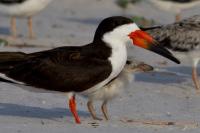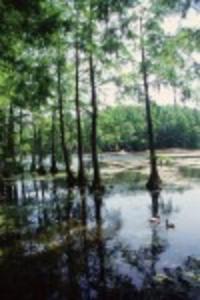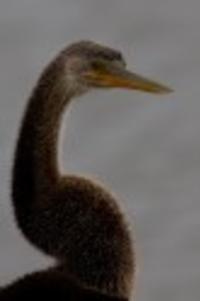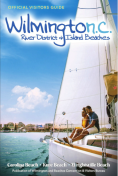Whether you’re admiring a Northern Cardinal on your backyard bird feeder or watching a squadron of Pelicans wing down the beach, birds bring wonder and enjoyment to our lives. They also remind us of the importance of protecting healthy habitats that support both birds and people.
Here on the coast, Southeast North Carolina offers a wide diversity of birds and habitats in which to find them. From barrier islands and inlets that offer refuge for migratory sandpipers that fly thousands of miles from Arctic breeding grounds to rest and winter in North Carolina, to leafy forests that shelter brightly colored warblers, there are many adventures awaiting anyone who wants to pick up a pair of binoculars and go in search of birds. Anyone, from a novice to a long-time nature lover can appreciate the birdlife our area has to offer.
 Birds’ lives usually revolve around migration, the annual movements between nesting and wintering grounds that sometimes span thousands of miles and cross continents. Through the seasons, visitors and residents can view wintering birds that descend from the north to enjoy more moderate winters, migrating birds that are stopping over to rest and refuel on their long journeys, and nesting birds that find safe places to raise their young in our beaches, marshes, and forests.
Birds’ lives usually revolve around migration, the annual movements between nesting and wintering grounds that sometimes span thousands of miles and cross continents. Through the seasons, visitors and residents can view wintering birds that descend from the north to enjoy more moderate winters, migrating birds that are stopping over to rest and refuel on their long journeys, and nesting birds that find safe places to raise their young in our beaches, marshes, and forests.
While there are many great places to see birds in every month of the year, we’ll list one site for each season below.
Winter (November-February):
Fort Fisher State Recreation Area & Fort Fisher State Historic Site
 Just south of Carolina Beach and Kure Beach, Fort Fisher offers great opportunities for winter birdwatching. There are several miles of trails through maritime forest, as well as marshes and beaches. In the forests, a variety of warblers can be found, and in open areas look on telephone wires to spot a Loggerhead Shrike or a Peregrine Falcon. Both are predators, though they are very different in size. The mockingbird-sized shrike sports a dapper black mask, a uniform gray back, and a white belly. It feeds on insects, sometimes storing one for later by impaling it on a twig or spur of barbed wire fencing. The Peregrine Falcon is the world’s fastest bird, exceeding 200 mph in its aerial dives as it pursues other birds for a meal. Meanwhile, on the ocean side you might look out to see and spot wintering seabirds like sleek Red-throated Loons and brightly billed Surf Scoters. Finally, at high tide check out the area near the boat ramp where flocks of American Oystercatchers congregate. These shorebirds are one of the only birds that feed primarily on shellfish, which they pry open with bright orange bills.
Just south of Carolina Beach and Kure Beach, Fort Fisher offers great opportunities for winter birdwatching. There are several miles of trails through maritime forest, as well as marshes and beaches. In the forests, a variety of warblers can be found, and in open areas look on telephone wires to spot a Loggerhead Shrike or a Peregrine Falcon. Both are predators, though they are very different in size. The mockingbird-sized shrike sports a dapper black mask, a uniform gray back, and a white belly. It feeds on insects, sometimes storing one for later by impaling it on a twig or spur of barbed wire fencing. The Peregrine Falcon is the world’s fastest bird, exceeding 200 mph in its aerial dives as it pursues other birds for a meal. Meanwhile, on the ocean side you might look out to see and spot wintering seabirds like sleek Red-throated Loons and brightly billed Surf Scoters. Finally, at high tide check out the area near the boat ramp where flocks of American Oystercatchers congregate. These shorebirds are one of the only birds that feed primarily on shellfish, which they pry open with bright orange bills.
Spring Migration (March-May): Holly Shelter Game Land
Located in Hampstead (just north of Wilmington), Holly Shelter Game Land consists of over 10,000 acres of longleaf pine forest, a habitat unique to the southeast. As such, it also hosts some species of birds that are found nowhere else. The Red-cockaded Woodpecker excavates its nests exclusively in living longleaf pine trees. These social birds live in family groups and cooperatively raise young. In addition to these dapper woodpeckers, you might find Northern Bobwhite (quail) and Bachman’s Sparrows. Many other species nest here, and you might see or hear Brown-headed Nuthatches (their call sounds like a rubber duck squeaking), Blue Grosbeaks, or a Chick-will’s-widow (their name is an interpretation of how their call sounds). Since the area is also a hunting preserve, visitors should check for the current regulations before visiting; non-hunting days are best for birdwatching. Several local groups (see below) periodically lead birding trips there, too. Finally, other rare species may be found in Holly Shelter, including the endemic Venus flytrap. All plants are protected by law and may not be removed, and they are a treat to see growing wild.
Nesting (April-August): The south end of South Wrightsville Beach
 Though most people associate nests built out of twigs and constructed in trees with nesting birds, coastal birds take another route. Many species nest on sandy beaches, making a simple scrape in the sand to deposit their eggs. Though the eggs are well camouflaged to blend in with sand and shell, they are vulnerable to the hot summer sun and predators, so the devoted parents stand over them in the heat of the day to shade them and zealously guard them from gulls and crows that would make a quick meal. When the chicks hatch, they resemble cotton balls on toothpick legs. In a few short weeks, the chicks grow into new fledglings, learning to fly and join their parents on their southward migration at the end of summer. This spectacle is unlike any other, and the best place to see it in the state is right on Wrightsville Beach. Visitors to the south end (Public Access 43 or 44) will find the birds’ nesting area designated with posts, string, and colorful signs made by the local elementary schoolers. Spunky Least Terns, graceful Black Skimmers, and striking American Oystercatchers are among the species that can be viewed. Audubon North Carolina protects the site and offers free weekly bird walks every Monday morning at 9 a.m. Tours meet at the gazebo at Access 43.
Though most people associate nests built out of twigs and constructed in trees with nesting birds, coastal birds take another route. Many species nest on sandy beaches, making a simple scrape in the sand to deposit their eggs. Though the eggs are well camouflaged to blend in with sand and shell, they are vulnerable to the hot summer sun and predators, so the devoted parents stand over them in the heat of the day to shade them and zealously guard them from gulls and crows that would make a quick meal. When the chicks hatch, they resemble cotton balls on toothpick legs. In a few short weeks, the chicks grow into new fledglings, learning to fly and join their parents on their southward migration at the end of summer. This spectacle is unlike any other, and the best place to see it in the state is right on Wrightsville Beach. Visitors to the south end (Public Access 43 or 44) will find the birds’ nesting area designated with posts, string, and colorful signs made by the local elementary schoolers. Spunky Least Terns, graceful Black Skimmers, and striking American Oystercatchers are among the species that can be viewed. Audubon North Carolina protects the site and offers free weekly bird walks every Monday morning at 9 a.m. Tours meet at the gazebo at Access 43.
Fall Migration (July-November): Greenfield Park, Wilmington
 Greenfield Lake is a historic millpond that has been turned into a park. Cypress trees have grown up around its border, and shrubs and magnolias offer additional habitat for a variety of birds from ducks to woodpeckers. In the springtime, the park is a wonderful place to go to look for migrating warblers. A footpath circles the lake, and the shrubs and trees are often alive with birds like the American Redstart, the Blue-gray Gnatcatcher, and the Myrtle Warbler hunting up their next fruit or insect meal. Many of these tiny birds will end up in Canada’s Boreal forest to nest during the summer time, and winter will find them in Central or South America. They stop over at places like Greenfield Park because the habitat there provides them with plentiful food to fuel their flights. On the water’s edge look for majestic Great Egrets and Great Blue Herons foraging for frogs and small fish. Some of these species migrate too, but others nest in North Carolina. On the water, you might see Double-crested Cormorants and Anhingas diving for fish. Several local groups (see below) periodically lead birding trips there, or just take a stroll by yourself and explore on your own.
Greenfield Lake is a historic millpond that has been turned into a park. Cypress trees have grown up around its border, and shrubs and magnolias offer additional habitat for a variety of birds from ducks to woodpeckers. In the springtime, the park is a wonderful place to go to look for migrating warblers. A footpath circles the lake, and the shrubs and trees are often alive with birds like the American Redstart, the Blue-gray Gnatcatcher, and the Myrtle Warbler hunting up their next fruit or insect meal. Many of these tiny birds will end up in Canada’s Boreal forest to nest during the summer time, and winter will find them in Central or South America. They stop over at places like Greenfield Park because the habitat there provides them with plentiful food to fuel their flights. On the water’s edge look for majestic Great Egrets and Great Blue Herons foraging for frogs and small fish. Some of these species migrate too, but others nest in North Carolina. On the water, you might see Double-crested Cormorants and Anhingas diving for fish. Several local groups (see below) periodically lead birding trips there, or just take a stroll by yourself and explore on your own.
How to get connected with birds locally:
The North Carolina Birding Trail catalogs the best places in the state to see birds and provides information about how to get there and what to look for. There are 20 sites in Brunswick, Pender, and New Hanover Counties to explore, nine of which are located in Wilmington (Airlie Gardens, Greenfield Park, Oakdale Cemetery & Smith Creek Park), Carolina Beach (Carolina Beach State Park), Kure Beach (Fort Fisher State Historic Site & Fort Fisher State Recreation Area), and Wrightsville Beach (Mason Inlet Waterbird Management Area & Mas onboro Island Reserve).
onboro Island Reserve).
The Cape Fear Audubon Society offers guided field trips throughout the year. Check out their website for a calendar of events and for information about how to attract birds to your yard with native plants.
Halyburton Park in Wilmington provides a variety of nature and birding programs and field trips for children as well as adults, including kayaking adventures and nature-themed arts and crafts projects for kids.
Wild Bird and Garden in Wilmington and Southport schedules local and out-of-town birdwatching trips throughout the year, including weekly walks in Airlie Gardens.
*Photos #2, #4, #5 (birds) are courtesy of Lindsay Addison, Audubon North Carolina
About Audubon North Carolina:

The mission of the National Audubon Society's North Carolina State Office is to help conserve and restore the North Carolina habitats we share with all wildlife, focusing on the needs of birds. Audubon North Carolina achieves its mission through a blend of science-based research and conservation, education and outreach, and advocacy. For more information: http://nc.audubon.org/


